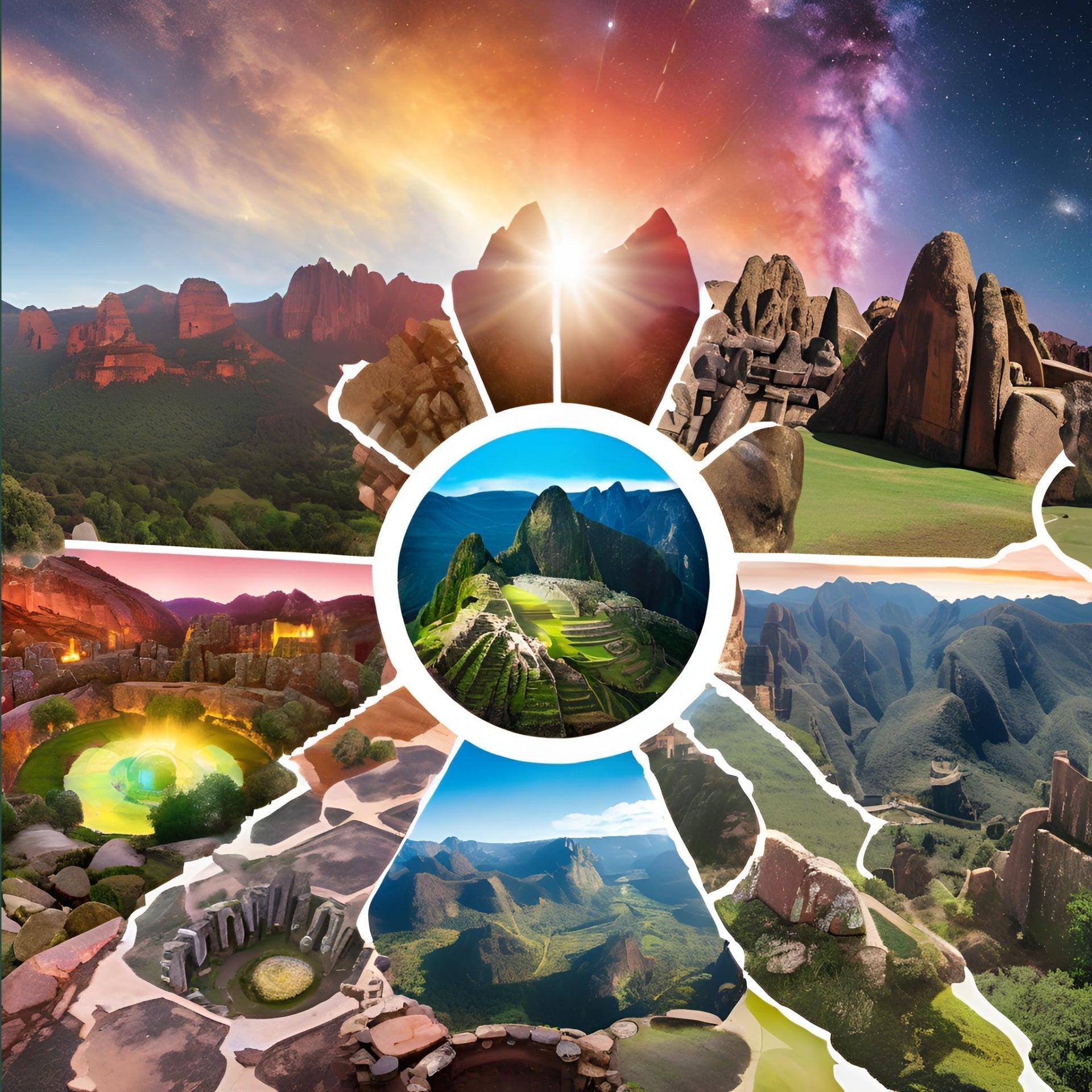

Reconnect with the Universe: The 5 Most Energetic Places on Earth
The Earth is filled with vibrant energy centres—places where natural beauty, spiritual significance, and unique geological formations converge, creating spaces that seem to pulse with life. These locations, often referred to as "energy centres of the universe," are believed to be places where the Earth's energy is particularly powerful, offering visitors a chance to reconnect with the universe on a deeper level.
What is an Energy Center of the Universe?
Energy centres, or "vortexes," are locations on Earth where the energy is believed to be magnified. These sites are often linked to ancient spiritual practices and are considered hotspots of healing, inspiration, and transformation. The energy at these sites is thought to affect the physical, emotional, and spiritual well-being of those who visit, providing a unique opportunity to reconnect with the natural world and one's inner self. While the concept of energy centers can be rooted in spiritual beliefs, there is also scientific interest in the geomagnetic and geological characteristics of these sites.
Here are five of the most energetic places on Earth where you can experience the universe's energy firsthand:
1. Sedona, Arizona, USA
Where is it?
Located in the American Southwest, Sedona is a city nestled among red rock formations in Arizona.
What’s Special About It?
Sedona is renowned for its stunning red rock landscapes, spiritual significance, and, most famously, its energy vortexes. These vortexes are specific sites in the area where the Earth's energy is believed to be especially strong. People from around the world come to Sedona for spiritual healing, meditation, and to experience the energy fields that are said to enhance self-awareness and spiritual growth.
Scientific Aspects:
While the concept of vortexes remains largely a spiritual or metaphysical belief, there is evidence that Sedona has unique geomagnetic properties. Researchers have measured unusual magnetic anomalies in the area, which could explain the heightened sensations people report.
What Does It Look Like?
Sedona is characterised by its dramatic red sandstone formations, which glow in brilliant hues of red and orange at sunrise and sunset. Towering spires, mesas, and buttes provide a stunning backdrop against deep blue skies and lush green junipers.

Source: Backland | glamping -
2. Machu Picchu, Peru
Where is it?
Machu Picchu is an ancient Incan city set high in the Andes Mountains of Peru.
What’s Special About It?
This UNESCO World Heritage Site is considered one of the most powerful energy centres on Earth. Its historical significance, combined with its breathtaking location and the mystery surrounding its construction, make it a magnet for those seeking spiritual and energetic experiences. Visitors often report feeling a deep connection to the Earth and a sense of timelessness while exploring the ruins.
Scientific Aspects:
Machu Picchu’s location on a geologically active fault line could contribute to its status as an energy centre. The Inca were known for their astronomical and geological knowledge, and Machu Picchu’s alignment with certain celestial events suggests a sophisticated understanding of energy and its flow through the land.
What Does It Look Like?
Perched on a mountain ridge, Machu Picchu is surrounded by lush green terraces, soaring peaks, and thick cloud forest. The iconic ruins include intricately constructed stone buildings, plazas, and temples that seem to blend seamlessly with the natural landscape.

source: PeruTravel
3. Stonehenge, England
Where is it?
Stonehenge is located on Salisbury Plain in Wiltshire, England.
What’s Special About It?
Stonehenge is one of the most famous prehistoric monuments in the world, with its massive standing stones arranged in a circular pattern. This ancient site is believed to be an energy center where the alignment of the stones with the solstices and lunar cycles suggests a deep connection to cosmic energy. It's a place of pilgrimage for those seeking to connect with ancient wisdom and the energies of the Earth.
Scientific Aspects:
The stones are aligned with the sunrise of the summer solstice and the sunset of the winter solstice, indicating a significant astronomical purpose. Additionally, some researchers have suggested that the area may have heightened electromagnetic properties.
What Does It Look Like?
Stonehenge consists of a ring of standing stones, each around 13 feet high, seven feet wide, and weighing about 25 tons. The landscape is open and grassy, often shrouded in mist, adding to the mystical atmosphere of the site.
source: Stonehenge tours

4. Uluru (Ayers Rock), Australia
Where is it?
Uluru is located in the heart of the Northern Territory in Australia, within the Uluru-Kata Tjuta National Park.
What’s Special About It?
Uluru is a massive sandstone monolith that rises abruptly from the surrounding desert plains. It is a deeply sacred site to the Indigenous Anangu people, who believe it holds spiritual significance and ancestral stories. Visitors often describe feeling a powerful sense of peace and connection when near Uluru, making it a revered energy center.
Scientific Aspects:
Uluru is part of an ancient rock formation that dates back around 600 million years. It's geological features include naturally occurring magnetic anomalies, and the iron content in the rock gives it a unique ability to change colours throughout the day.
What Does It Look Like?
Uluru is iconic for its imposing size and striking reddish-brown color, which shifts dramatically with the light from dawn to dusk. The surrounding landscape is sparse and arid, dotted with spinifex grasses and occasional shrubs, enhancing the monolith's prominence.

source: Uluru's rock
5. Rila Monastery, Bulgaria
Where is it?
Rila Monastery is located in the Rila Mountains of southwestern Bulgaria.
What’s Special About It?
Rila Monastery is not only a UNESCO World Heritage Site but also one of the most significant spiritual and energetic places in Eastern Europe. Founded in the 10th century by the hermit St. Ivan of Rila, it has long been a pilgrimage site for those seeking spiritual growth and healing. The monastery is nestled in a mountain range that is said to have powerful energy fields, attracting visitors who wish to meditate, pray, and connect with the natural energies of the area.
Scientific Aspects:
The Rila Mountains are known for their unique geomagnetic properties and pristine environment, which contribute to the sense of heightened energy. The clear air, abundant flora, and the presence of numerous mineral springs add to the site's reputation as a place of rejuvenation and spiritual cleansing.
What Does It Look Like?
Rila Monastery is a striking architectural complex featuring colorful frescoes, intricate wood carvings, and a stunning mountain backdrop. The main church, with its black-and-white striped facade and golden domes, stands out against the lush green landscape and snow-capped peaks, creating a serene and inspiring setting.

source: Rila Monastery
The Power of Ceremonial Cacao
Ceremonial cacao is another powerful way to enhance one’s connection with the Earth's energy. Used for centuries by indigenous cultures, cacao ceremonies are a heart-opening practice that promotes spiritual awakening, mental clarity, and emotional healing. The natural compounds in cacao, such as theobromine, magnesium, and antioxidants, are believed to elevate mood, increase focus, and promote a sense of well-being.

Incorporating ceremonial cacao into your experience at these energy centres can deepen your connection to the Earth's energies. The practice encourages mindfulness, gratitude, and an open heart, making it an ideal companion for spiritual exploration and personal growth at these powerful sites. As you journey to these energy centres or create your own space of connection, consider ceremonial cacao as a tool to amplify the experience and draw you closer to the universal energies that surround us.
if you are interested to try Ceremonial grade cacao to deepen your connection to one self or the earth. You can find more information here on our website.

Let us know if you have visited any of these spiritual centres? which one would you like to visit most? or any others that could be added to this list (there are many).





